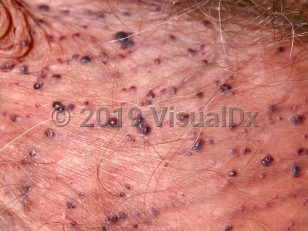Fordyce angiokeratoma of scrotum
See also in: AnogenitalAlerts and Notices
Important News & Links
Synopsis

Angiokeratomas of the scrotum (Fordyce angiokeratomas) are benign, often asymptomatic, 2-5 mm, warty or smooth-topped, red-to-violaceous papules composed of dilated dermal capillaries. The pathophysiology is unknown, but it is speculated that they may be caused by increased venous pressure due to their occasional association with vascular conditions such as varicoceles. The lesions may bleed spontaneously or with slight trauma, which is often distressing to patients.
The condition is more common in men. However, angiokeratomas may also be seen on the inner thighs, lower abdomen, and on the vulva in women (angiokeratoma of vulva). Prevalence data indicates that the condition is more common in individuals of Northern European and Japanese descent, and that incidence increases with advancing age.
The condition is more common in men. However, angiokeratomas may also be seen on the inner thighs, lower abdomen, and on the vulva in women (angiokeratoma of vulva). Prevalence data indicates that the condition is more common in individuals of Northern European and Japanese descent, and that incidence increases with advancing age.
Codes
ICD10CM:
D29.4 – Benign neoplasm of scrotum
SNOMEDCT:
735082004 – Fordyce angiokeratoma of scrotum
D29.4 – Benign neoplasm of scrotum
SNOMEDCT:
735082004 – Fordyce angiokeratoma of scrotum
Look For
Subscription Required
Diagnostic Pearls
Subscription Required
Differential Diagnosis & Pitfalls

To perform a comparison, select diagnoses from the classic differential
Subscription Required
Best Tests
Subscription Required
Management Pearls
Subscription Required
Therapy
Subscription Required
References
Subscription Required
Last Reviewed:08/03/2021
Last Updated:08/08/2021
Last Updated:08/08/2021
Fordyce angiokeratoma of scrotum
See also in: Anogenital
